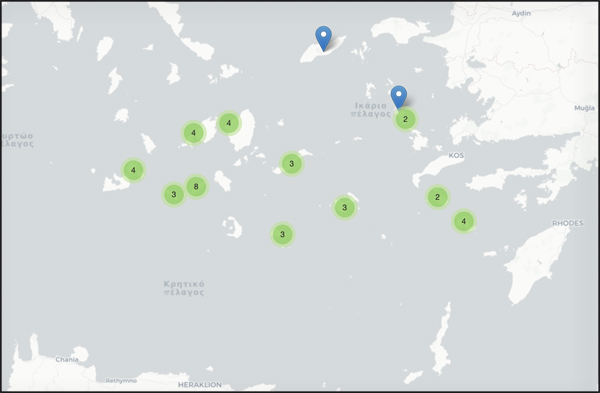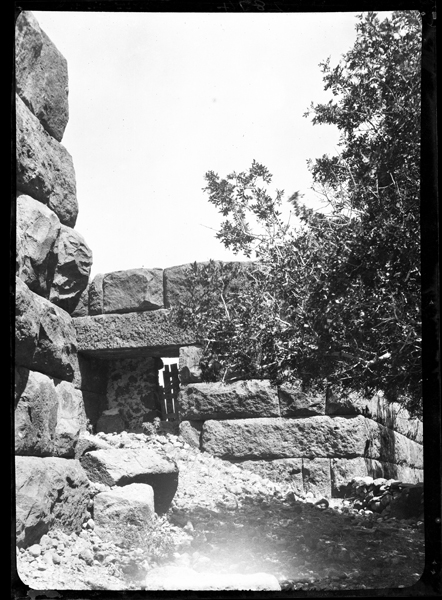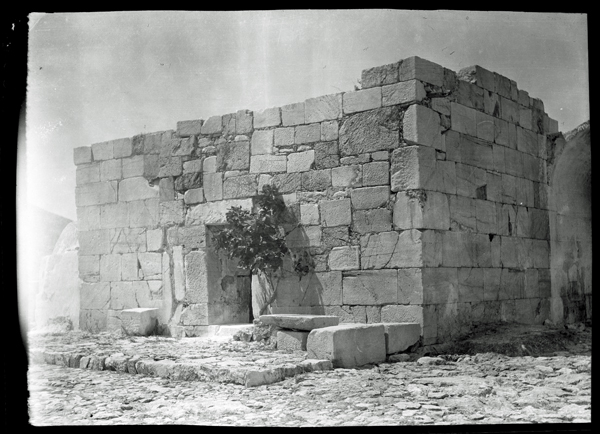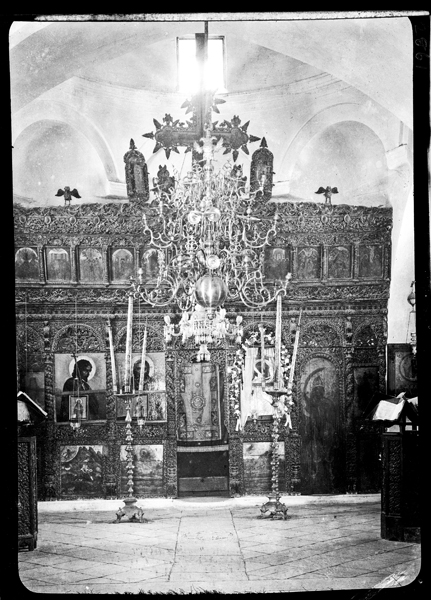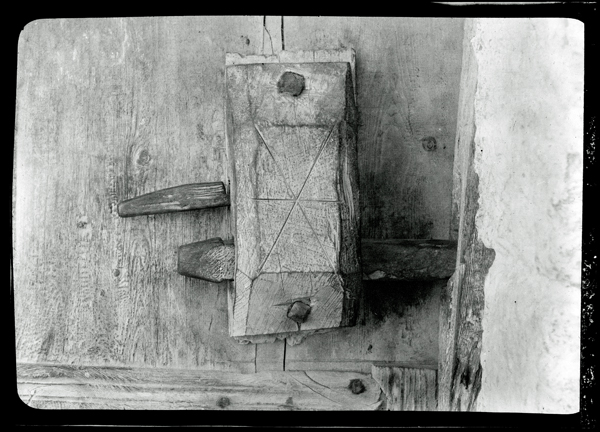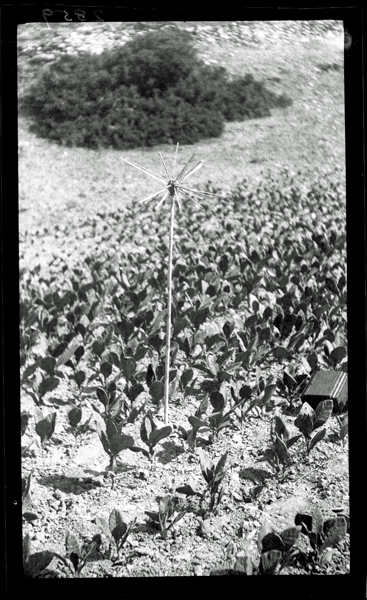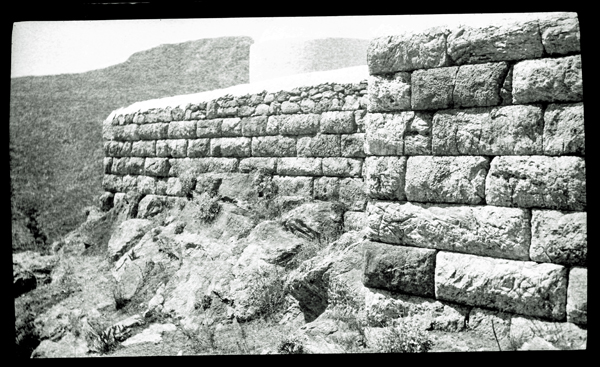Island Observations: A.J.B. Wace & R.M. Dawkins in the Southern Aegean 1906-1907
How can visual media tell a story? Image-based observations are often dependent on context – who composed them, what they show, when and possibly why they were created. It also depends on who the story is told to. Many of these SPHS-related Archive Stories are told through photographs with a required textual input – minimally in the form of brief, factual accounts of activities in the Annual Reports of the British School at Athens (BSA) published in the Annual of the British School at Athens (ABSA). The photographs take on specific meaning, grouped around individual(s) or event(s). Even then, they are not complete. The story can be fleshed out – more or less – with yet more textual evidence from both published and unpublished accounts, keeping in mind that these fuller textual sources are biased, telling versions of the story for specific audiences.
An event that illustrates this process begins with Richard M. Dawkins and Alan J.B. Wace who enjoyed a long period of shared academic interests and work. One such joint venture they embarked on was their exploration of the Cyclades and the Dodecanese early in the years of Dawkins’ Directorship of the BSA (1906-1913). The ABSA Annual Report for 1905/1906 records that, in the spring of 1906, Dawkins and Wace travelled to “a number of the less-known Turkish islands, studying the conditions of modern life as well as the ancient remains, and collecting information about local styles of embroidery.” However, it is clear from unpublished sources and a brief mention in an article by Dawkins on the Temple of Apollo at Sikinos that they also travelled to the islands again in 1907, a fact not mentioned in the 1906/1907 Annual Report.
Ann French, in her 2009 article in Scholars, Travels, Archives: Greek History and Culture Through the British School at Athens, used unpublished material from both Wace and Dawkins to indicate that the primary purpose for their travels to the islands was for the collection of embroideries and that between them, they eventually collected over 1,200 textiles. These now form the basis of the Wace and Dawkins collections of Greek textiles at the Victoria and Albert Museum along with Wace’s major contributions to the textile collections in Liverpool and the Textile Museum in Washington, D.C. In addition, according to Ann French, Wace also collected ‘artefacts’ of “contemporary Greek ‘ethnographic’ material such as shadow puppets [Καραγκιόζης], cafe posters, amulets, and accessories for performing at carnivals”. Further, Dawkins remarked in his unpublished autobiography (held by Oxford University) that while travelling in the islands, he continued his dialectical collecting – building on linguistic and folklore studies he began on Karpathos in 1903. In other words, they were eclectic in their collecting and observations, something that was only cursorily remarked on in the 1905/1906 Annual Report.
The BSA SPHS Image Collection contains a group of 42 photographs from Dawkins’ and Wace’s visits to the islands. These were selected and deemed suitable to deposit with the SPHS photographic collection by Wace, although some were actually photographed by Dawkins. The images cover twelve islands in the Dodecanese and Cycladic island groups. It is significant that there are no photographs of textiles, possibly because black and white photography would not have done justice to the embroideries’ colour and stitching detail even if they would have provided documentary evidence. The oral collection of dialects and folktales are, by definition, also absent. As you would expect, many of the images are of ancient and medieval remains, ancient structures that had been converted to churches such as the Temple of Apollo in Sikinos and the Temple of Apollo Aiglitis on Anaphi as well as modern life in the form of street scenes, contemporary architecture and church interiors.
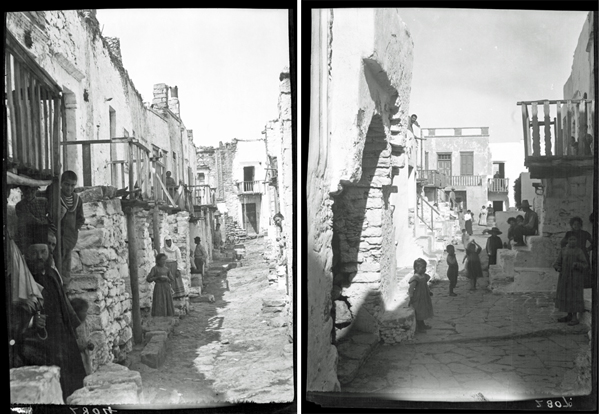
Street Scenes. Left: BSA SPHS 01/0988.2804. Kimolos town: S. street. Right: BSA SPHS 01/0991.2807. Folegandros town: Street.
A smaller number of photographs can be classed as specifically ‘ethnographic’. One such is the wooden lock Wace photographed on the island of Tilos, a type Dawkins discusses at length in his 1903 article in the ABSA recounting his Karpathos visit. Dawkins remarked that these wooden objects were fast going out of use, but were significant in retaining elements of ancient locking mechanisms, possibly even descendants of the Homeric lock. Another photograph, also by Wace, shows a talisman for protection against the evil eye in a tobacco field on the island of Amorgos.
Wace and Dawkins published one story based on their island observations. The article was intended for an academic audience, published in the 1905/1906 volume of the ABSA. The text focused on the ancient and medieval remains on four islands: Astypalaea, Telos (Tilos), Nisyros, and Leros. All but one of the figures in the article are of fortifications (towers, gates, walls, etc.), seven of which are in the BSA SPHS collection. Their intention in the article, they stated, was to provide bibliography and notes for (archaeologically-inclined) travellers and perhaps to form the basis for further, more detailed, researches in the islands. The article was similar in scope to Dawkins’ earlier publication of his visit to Karpathos, but more rigorous in adhering solely to observable ancient and medieval remains. What is absent is a discussion of the modern customs on which Dawkins dwelled in 1903.
In 1936, another story was told through these images to a different audience. Island observations collected by Wace and Dawkins were singled out for display at an exhibition that was held in Burlington House (London) to celebrate the first 50 years of the activities of the BSA. Display boards illustrating the work of the BSA were created for the exhibition consisting of drawings and photographs. The photographs were primarily selected from the SPHS photographic collection, originally donated by the same BSA scholars whose work was displayed on the boards. The journeys by Dawkins and Wace to the islands were distilled down to three display boards (Numbers 395, 396 and 397). The Exhibition catalogue introduces these three collectively as:
The Greek Islands are famous for their mythical beauty, but they have countless other attractions. The antiquities, prehistoric and historic are too little known; the churches and monasteries are well worth attention and the very mention of the Italian Dukes of the Archipelago suggests romance.
The boards are all slightly different. Board 395 from Dawkins’ 1903 visit to Karpathos contains only drawings – a copy of a map of the island based on the British Admiralty Chart, two sketches of different approaches to the village of Elymbos, and sketches of wooden objects (lock and olive press). All these drawings appear in Dawkins’ ABSA article on Karpathos. The next two boards (396 and 397) show images from their 1906 and 1907 travels around the islands. Board 396 contains one photograph from the SPHS collection and a sketch plan of the church, both of which appear in Dawkins’ publication on the Temple of Apollo on Sikinos. Dawkins described the temple as a surviving vestige of antiquity preserved by its conversion to a church – in other words, the structure was an untouched historical document that recorded the use of the building through time. Board 397 contains a number of SPHS images, primarily by Wace from their 1906 and 1907 travels. The photograph of the port of Ayia Marina on Leros, however, dates to 1912 and was taken by F.W. Hasluck.
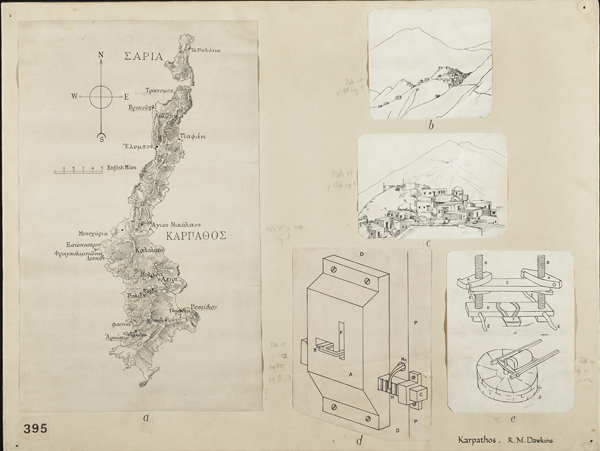
Board 395. Karpathos was visited by R.M. Dawkins in 1903. The board contains a British Admiralty Chart, sketched views, and drawings of a wooden lock and olive press.
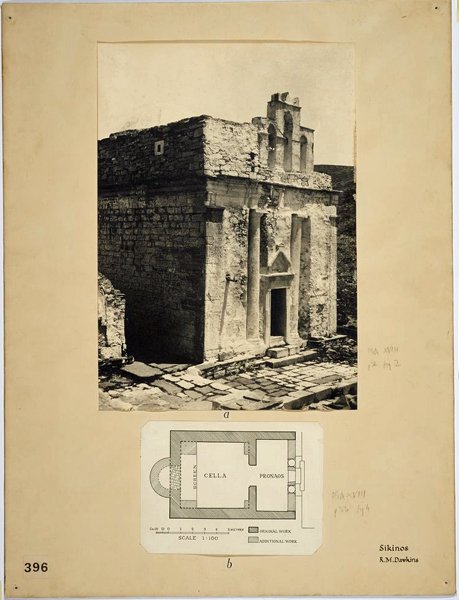
Board 396. The Temple of Apollo in Sikinos is of Hellenic date and construction; but by the addition of an apse and a belfry, the classical building has been adapted for use as a Greek church, and as such it is still occasionally used. A Greek Temple has thus survived; partly, too, because of the extreme remoteness of the island. Photograph [BSA SPHS 01/0998.2815] and plan by R.M. Dawkins.

Board 397. Composed of photographs of carved and gilt church screens [BSA SPHS 01/1043.2861 and BSA SPHS 01/1045.2863], distant views of towns an]d ports [BSA SPHS 01/1538.3969 and BSA SPHS 01/1064.2882], and ancient and medieval stone walls [BSA SPHS 01/1050.2868 and BSA SPHS 01/1056.2874].
These three illustrated boards, telling the story of their island explorations, were placed in the general section reserved for Studies of Modern Greek Life. By placing them in this section, the Exhibition stressed the act of ‘modern’ exploration over the study of antiquities. Emotive keywords ‘mythical beauty’ and ‘romance’ were included in the catalogue introduction. In other words, Wace’s and Dawkins’ travels around the Dodecanese and Cyclades were billed as adventurous exploits to unfamiliar foreign islands, conjuring up images of the romantic past. It shouldn’t be forgotten that the material was arranged for a public audience, not a strictly academic one.
The photographs donated by Wace and Dawkins to the SPHS depict, on one hand, a story of scholarly interests in the islands as conveyed in their academic articles and, on the other hand, a different story of modern exploration to a public audience in the 1936 Exhibition. Yet, both academic and general public audiences were told incomplete stories that become more comprehensive when you factor in the primary reason for their island travels – the collection of embroideries. Textiles were not represented in the SPHS photographic collection. Similarly, textiles at the 1936 Burlington House Exhibition – which included some from the Wace and Dawkins collections – were segregated and displayed in a separate location, hung above the Byzantine exhibitions. By arranging the display this way, the embroideries were removed them from their context and highlighted in the catalogue as folk-art, described as being “famous for their high decorative qualities, for rich colour, fine execution and excellent design.” Yet, what Wace and Dawkins photographed still encapsulated much of their wide-range of interests in archaeology, historic monuments and the ‘ethnography’ of modern life in the islands. These images have the potential to convey a variety of visual messages – including this Archive Story based on reflections on the collection.
Deborah Harlan
British School at Athens
Images from the BSA-SPHS collection are available on the BSA’s Digital Collections page.
Click here for more BSA Archive Stories.
Further Reading
British School at Athens 1936. British Archaeological Discoveries in Greece and Crete 1886-1836: Catalogue of the Exhibition. London: Royal Academy of Arts.
Dawkins, R.M. 1902/1903. ‘Notes from Karpathos’, Annual of the British School at Athens, 9, pp. 176–210.
Dawkins, R.M. 1911/1912. ‘The Apollo Temple on Sikinos’, Annual of the British School at Athens, 18: 30–36.
Dawkins, R.M. and A.J.B. Wace 1905/1906. ‘Notes from the Sporades, Astypalaea, Telos, Nisyros, Leros’ Annual of the British School at Athens 12: 151-174
French, A. 2009. ‘The Greek embroidery collecting of R.M. Dawkins and A.J.B. Wace’, pp. 77–90 in Llewellyn Smith, M., Kitromilides, P.M., and Calligas, E. (eds) Scholars, Travels, Archives: Greek History and Culture Through the British School at Athens. London: British School at Athens (British School at Athens Studies)
